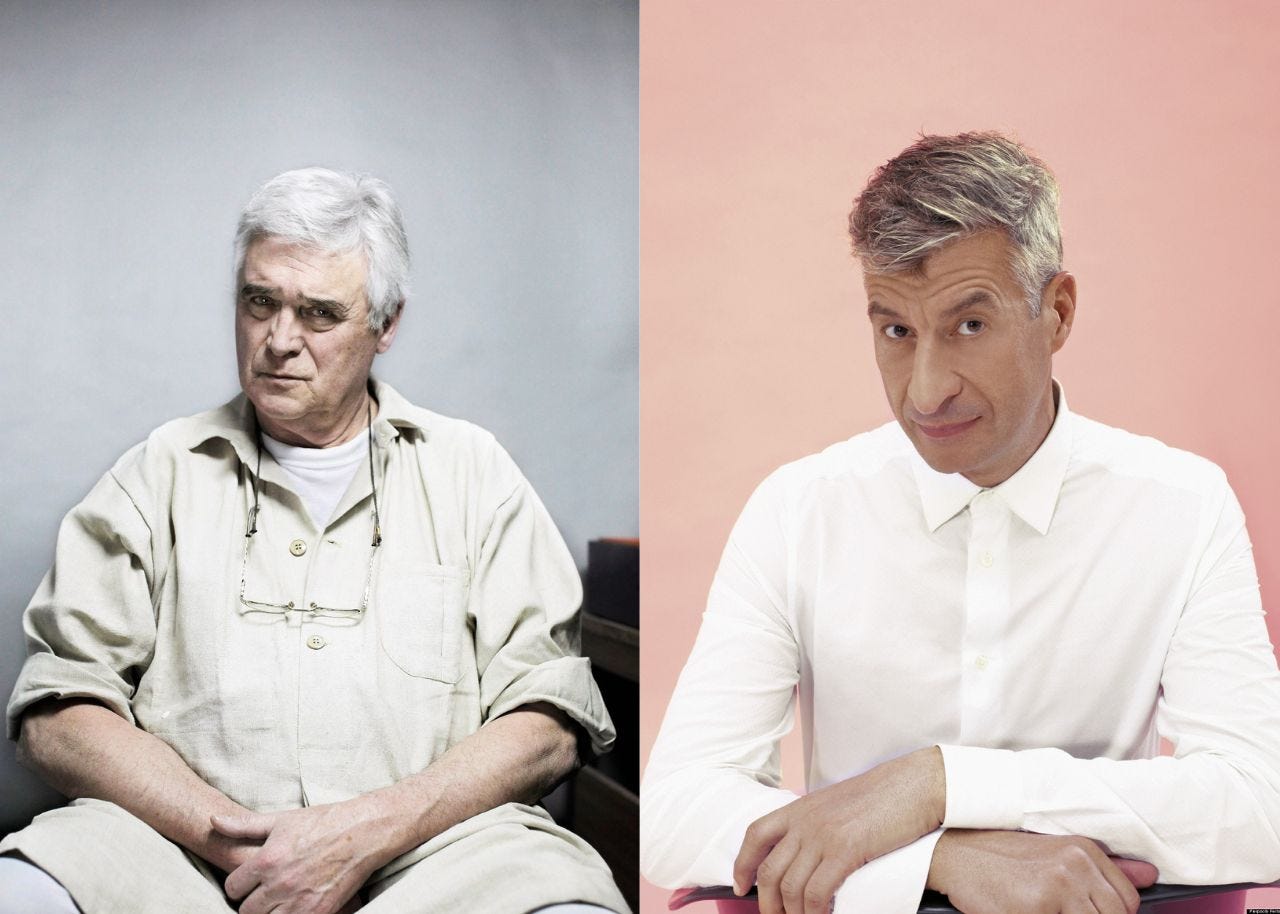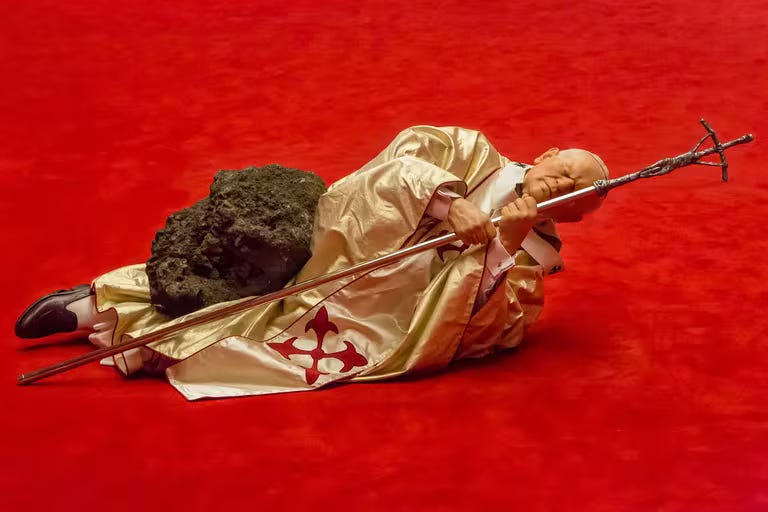Who is the author of the works of art?
The trial of Druet and Cattelan: Reflections on creativity and the future of art.
🏷️ Categories: Creativity, Art
Who is the author of the work?
This is the question the judges were asking themselves at the Paris Court of Cassation when Druet and Cattelan arrived in the courtroom. Daniel Druet, a French sculptor, had been between 1999 and 2006 sculpting on commission for Maurizio Cattelan, a reputed Italian artist. Cattelan had a contract with Druet whereby he paid him for the work, in return Cattelan received Druet's works and then sold them at art exhibitions at a much higher value (Collectif, 2022).
Druet one day got tired of being in the shadows and sued Cattelan to be recognized as the author of 9 of Cattelan's works. To Druet's surprise, the trial determined that Cattelan was the author even though Druet had been the material creator.
The reasons for this decision transcend the trial itself and make one reflect on the origin of human creativity and the future of art. Let’s see.
The case of Druet and Cattelan
Cattelan is known for provocative and challenging works.
Two of the works that catapulted him to fame, "Him" and "La nona ora" were not made by himself, but it was Druet who materialized Cattelan's conceptual visions.
"La Nona Ora" was sold for $3 million and "Him", for $17 million (Afp, 2016).
"La Nona Ora" is what you see, a hyper-realistic sculpture of Pope John Paul II at the exact moment when a meteorite passes through the roof of the church and crushes him.
"Him" is a sculpture by Druet in which controversy is once again served up. A hyper-realistic Hitler on his knees in miniature.
In addition, Cattelan is the author of this controversial work that you will probably know. Its name is "The Comedian" and it was sold in Miami for $12000 in 2019.
Grounds for the trial decision
Druet argued that, as the physical author of the works, he should receive recognition and monetary compensation commensurate with the value of the works.
The court denied him, arguing that authorship is not only of the one who physically creates the work, but also includes mental conception and creative direction. After reviewing their conversations, it became apparent that Cattelan gave Druet precise and detailed instructions on all aspects of the work he wanted. Druet had little creative freedom.
Does this sound like anything from the present day?
It does to me.
Cattelan is a human and Druet is ChatGPT.
Where does our creativity originate?
This case made me seriously reflect on the origin of creativity, a topic we have explored before from a psychological perspective.
Is creativity purely individual or is it a collaboration where different skills and visions intertwine? Authenticity in art does not lie in pure creativity, but in how the artist interprets and transforms the influences received into something new and personal.
There is no such thing as pure creativity.
The future of art and artificial intelligence
Similar to how Druet materialized Cattelan's visions, AI has the potential to act as a tool in the creative process.
AI is already being used in art, an example that impressed me is the project "The Next Rembrandt", where AI was used to analyze the style of the famous painter Rembrandt and create a new work that mimicked his technique and subject matter (The next Rembrandt, 2016).
This was the result.
Will AI create the culture we will consume in the future?
The question is no small thing.
If I hadn't warned you you'd think the above picture was painted by a human.
With AI capable of analyzing large amounts of data and generating derivative content, it could be argued that AI has the potential to profoundly influence cultural tastes and preferences. However, another question arises, even if it is capable of generating art on the same level as a human, would we accept that art and place value on it?
I believe that AI will indeed create culture, but it will not be autonomous.
AI will be just another tool of the artist, like a paintbrush for a painter and a chisel for a sculptor. I think we will end up accepting that art as human art as long as the AI is not autonomous and is under the orders of humans.
In that case the AI will be Druet and we will be Cattelan.
💭 It's your turn: Do you think AI will create the culture of the future or will we reject it?
✍️ Quote of the day: "Art allows us to find ourselves and lose ourselves at the same time." No Man is an Island, Thomas Merton.
Thanks for being on the other side 🙏, I send you a warm and human hug.
References 📚
Afp, L. M. A. (2016, 10 may). Une statue d’Hitler par Maurizio Cattelan adjugée pour plus de 15 millions d’euros à New York. Le Monde.fr. https://www.lemonde.fr/arts/article/2016/05/09/une-statue-d-hitler-par-maurizio-cattelan-adjugee-pour-plus-de-15-millions-d-euros-a-new-york_4915681_1655012.html
Collectif. (2022, 16 may). Affaire Daniel Druet-Maurizio Cattelan. Le Monde.fr. https://www.lemonde.fr/idees/article/2022/05/14/affaire-daniel-druet-maurizio-cattelan-c-est-bien-la-question-de-la-paternite-de-l-art-qui-est-au-c-ur-de-cette-dispute-et-de-ce-qui-fait-uvre_6126061_3232.html
Merton, T. (2005). No Man is an Island. Shambhala Publications.
The next Rembrandt. (2016). The Next Rembrandt. https://web.archive.org/web/20210513005509/https://www.nextrembrandt.com/











Interesting question. I can see and sort of agree with the judge in this, seeing as how this "collaboration" (or should I say artistic servitude) is common among famous artists and writers. They have "ghosts" who do a lot of work for them under their names. Also, professors who use grad students to do the heavy lifting for their research studies, only to credit the student(s) as "et al" on the title page.
Then there's this situation shown in this substack post today: https://readymades.substack.com/p/subversive-pop-art?publication_id=2610025&post_id=146139790&isFreemail=true&r=1gbs2n&triedRedirect=true&utm_source=substack&utm_medium=email
It shows a photo of Andy Warhol in front of his "re-presentation" of Brillo Boxes. I couldn't help thinking of the illustrator who designed that packaging only to have Warhol swipe it for an art piece and make a fortune from it. While the illustrator got instructions from his employers for this package design, is s/he the creator or is the employer? And is Warhol guilty of plagarism?